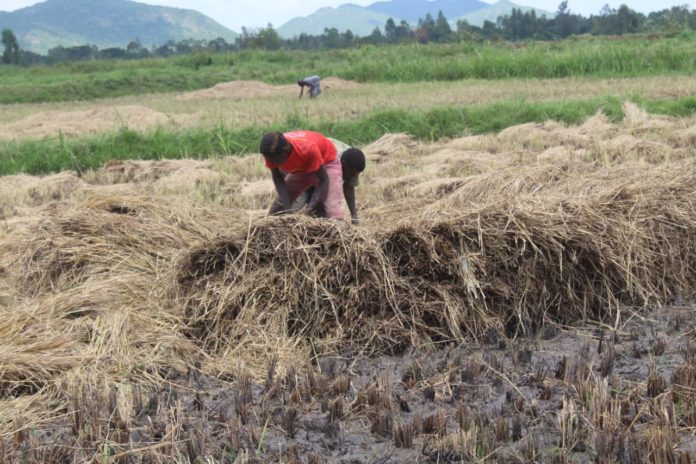By Robert Manyara
Busia County, Kenya: Godfrey Wanjala smiles saying that the arrival of combine harvesters is a blessing to the rice farmers who had been relying on the manual system of harvesting for many years, he asserted the loss of rice crop through spillage and winnowing.
“I have been growing and harvesting rice for so many years using the manual system of harvesting. This method is wasteful as a result of spillage, but since I started using a combine harvester to harvest my rice, I have gained a lot,” said Wanjala.
Wanjala a rice farmer from Bunyala rice irrigation scheme and a member of Magombe Multi-Purpose cooperative society, says apart from the crop loss through spillage during threshing and winnowing stages, birds especially the quelea species cause much damage to the rice crop at the harvesting stage.
“Birds have also done much damage to our rice crops that have reached the harvesting stage. We, therefore, have to wake up as early as 5 am to scare the birds away until late in the evening.”
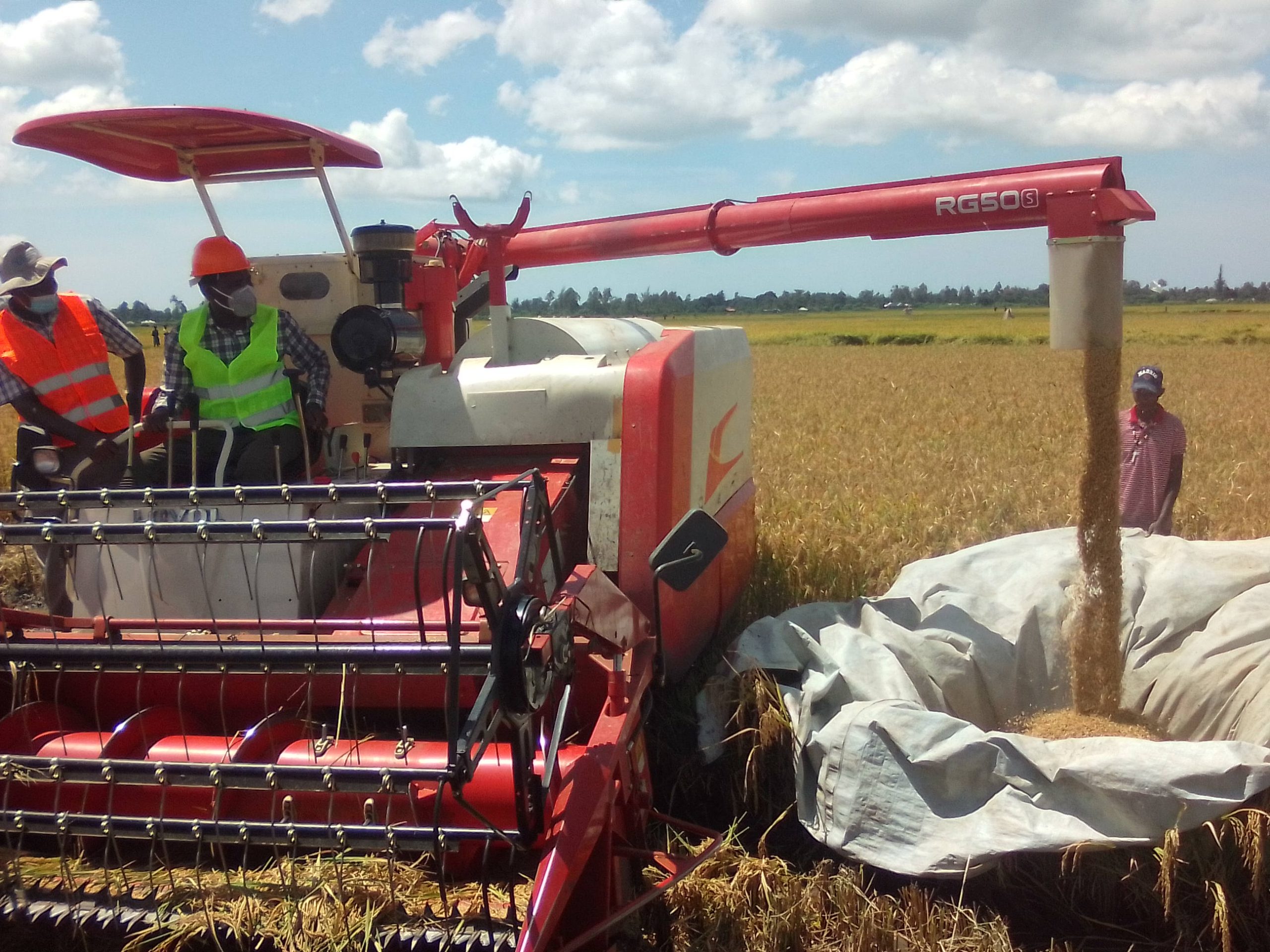
The proud owner of a two-acre parcel of land under rice says that with the modern method of harvesting he has managed to harvest a total of 45bags of rice per acre unlike before when he used to harvest only 25 bags of rice per acre.
Gladys, also a long-time rice farmer at Bunyala rice irrigation scheme has also not been excluded from the gains so far realized.
She says before the acquisition of the combine harvesters for them, she had been reaping a paltry twelve bags of rice per acre but with the arrival of the combine harvesters, she is now harvesting at least twenty bags of rice from her one-acre parcel of land.
“Initially I used to harvest only twelve bags of rice from. my one-acre rice farm but today I am able to harvest not less than twenty bags of rice from my one-acre farm,” she says.
Joachim Abungu, another rice farmer from Ruambwa/Mudembi rice irrigation scheme on his part says rice farming has, apart from providing for his Livelihood, enabled him to educate his children.
“Since I ventured into rice farming five years ago, my life has changed tremendously,” he said.
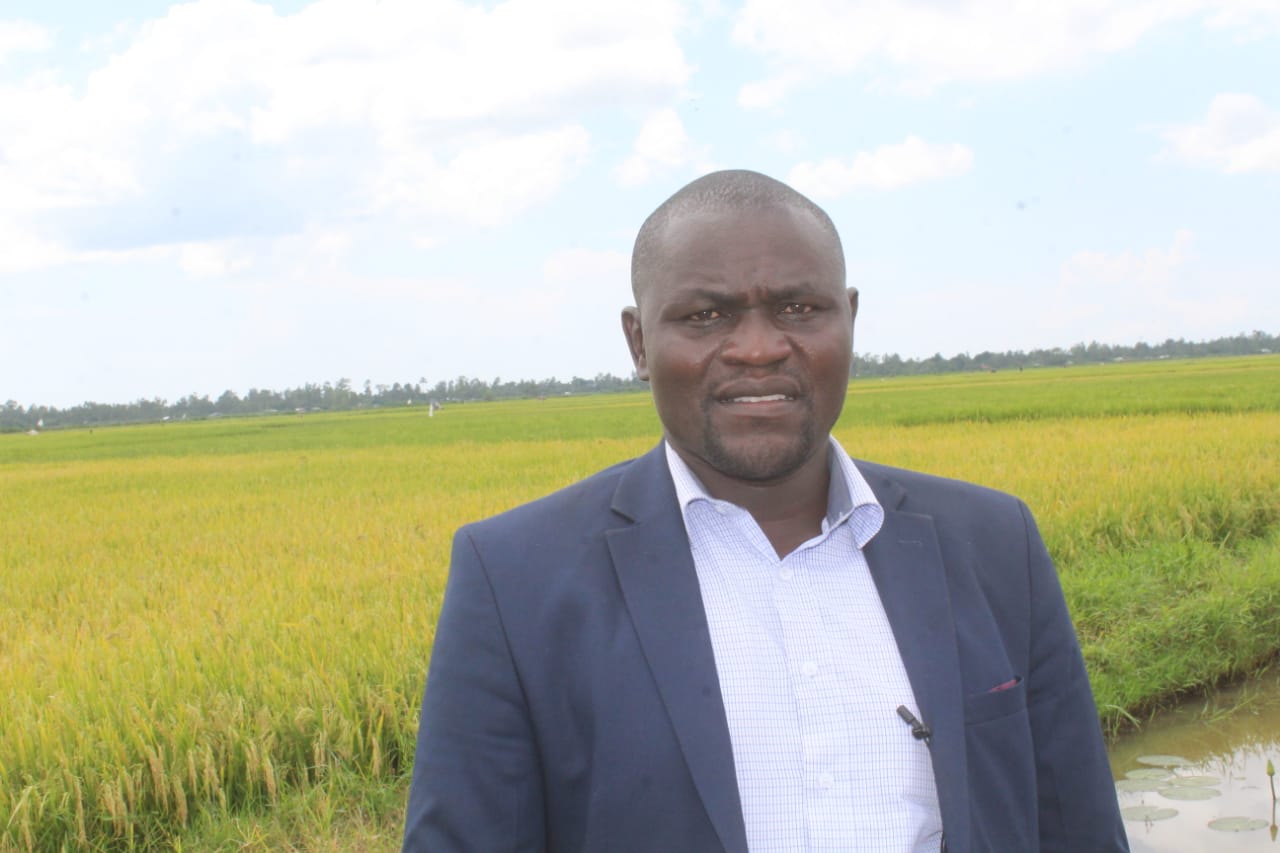
had this to reveal, “Where we are is Feeder One whichever is the main scheme and is one of the parts most affected by the floods that came in the month of May this year.
“Rice on the farm was supposed to be harvested in two months time so according to the soil experts, we would not be able to return the owners of the affected farms back to their respective farms immediately that is why it took three months to go back to the farms.”
Weeding has been done, they have cultivated the farms but those who had not planted resumed immediately and by now they have started harvesting their rice.
Challenges
The rice farmers had as well faced a lot of challenges because all their crops including farm inputs had completely been destroyed, a situation that forced them to begin afresh and we as the National Irrigation Board(NIB) unanimously resolved not to charge them for the water they had used because they had already paid initially.
There was also another challenge of getting seeds, fertilizer as well as money for farming. This was done for them by loan facilities from Magombe Multi-purpose cooperative society on the loan that would be repaid after they had harvested and sold their rice production.
The rice farmers were given seeds by the National government through the County government of Busia and were given basmati seeds although some of them exchanged it with another variety majority of them got assistance from the Busia County government.
However, the farmers met the cost of weeding as part of their contribution to go back to farming.
The National Irrigation Board connected the rice farmers with some people who could give them loans for buying the farm inputs and pay later in accordance with our own local arrangements to make sure the rice farms don’t remain idle for a long period of time.
250 acres area at the weeding level whereas 500 acres are about to be harvested because when we resumed farming after the flooding we opened about 1500 acres at the same time majority of which are at the harvesting stage.
The drying capacity is 300 bags of rice and over 10,000 bags have already been dried waiting to be taken for milling.
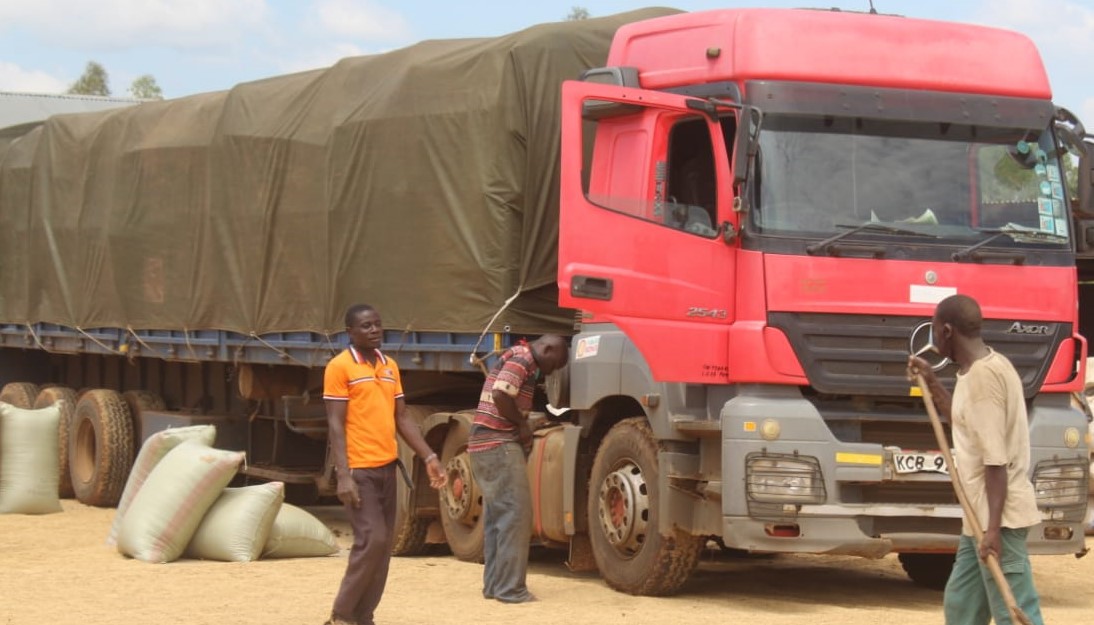
“The challenge we are facing is that we opened 1,000 acres that got ready at the same time due to lack of enough drying space.”
“And this has caused the rice to change color as a result of the camp dampness but we have managed to expand the drying space by providing the rice farmers with tarpaulins to dry their rice on while others do so from their respective homes then brings their rice here for weighing.” An official confirmed.
Now that the storage space is completely full we have been forced to use any available space but the problem is that we usually have buyers from Uganda but due to the corona pandemic the border was closed.
Bunyala rice irrigation scheme in Bunyala Sub County, Budalangi constituency of Busia county is among key rice irrigation schemes that engage in large-scale production of rice in Kenya.
The production of rice crops in the sub-county has produced positive results considering that the livelihoods of the local community have been transformed a great deal.
For the past fifty years since the first rice crop was planted and harvested in 1969, three years after independence, the rice farmers have been incurring huge losses amounting to millions of shillings as a result of the old fashioned manual harvesting method that had culminated into the spillage of rice during the threshing and winnowing stages.
Six years after the first rice crop was harvested, rice farmers came together and unanimously resolved to form a cooperative society in 1975 known as Magombe Multi-Purpose Cooperative society Ltd with a membership of eighty-four.
The key objective behind the setting up of the cooperative society was purely to Empower rice farmers through the provision of loans that would enable them to access the basic necessities like farm inputs, water, and seeds among others.
Magombe Multi-Purpose Cooperative society chairman Christopher Gunyi said the membership has shot up sharply from 84 to 272 with a total of 1934 farmers.
“Magombe Multi-Purpose Cooperatives society was formed forty-five years down the lime with a membership of only eighty-four but the number has presently risen to 272 since then. This is a remarkable improvement”, said the cooperative society chairman.”
The rice farmers owe their tremendous success to the Magombe Multi-Purpose Cooperative society that has since its formation over four decades ago been providing them with loan facilities to empower them to meet the cost of rice farming.
Manual harvesting system
The cooperative society chairman further says that rice farmers from Bunyala Irrigation scheme have been losing ten bags of rice per acre to the tune of ksh50,000 each harvesting season as a result of the manual Harvesting System that they have been using for five decades now.
“The manual harvesting system rice farmers from Bunyala Irrigation scheme have been using for the past fifty years has seen them incurring huge crop losses due to the spillage of rice totaling to the tune of ten bags of rice amounting to ksh50,000 per acre,” he said.
Gunyi said the loss rice farmers have incurred as a result of the manual harvesting system has forced the cooperative society to liaise with various stakeholders who have provided the rice farmers with two combined Harvesters privately owned by rice farmers from the Mwea Irrigation Scheme.
“We also have another investor,an Indian in Nairobi who is partnering with us and has also provided us with another combine harvester bringing the total to three,” said the Cooperative society chairman.
He said this season some farms are too wet to an extent that the combine harvester cannot access to do the Harvesting thereby forcing the owners of the affected rice farms to continue using the manual system of harvesting.
“But over 500 acres of the rice farms have been harvested using combine harvesters and this has seen rice farmers gaining from between 25 to 45 bags of rice per acre unlike before when they used to harvest only twelve bags of rice per acre,” he added.
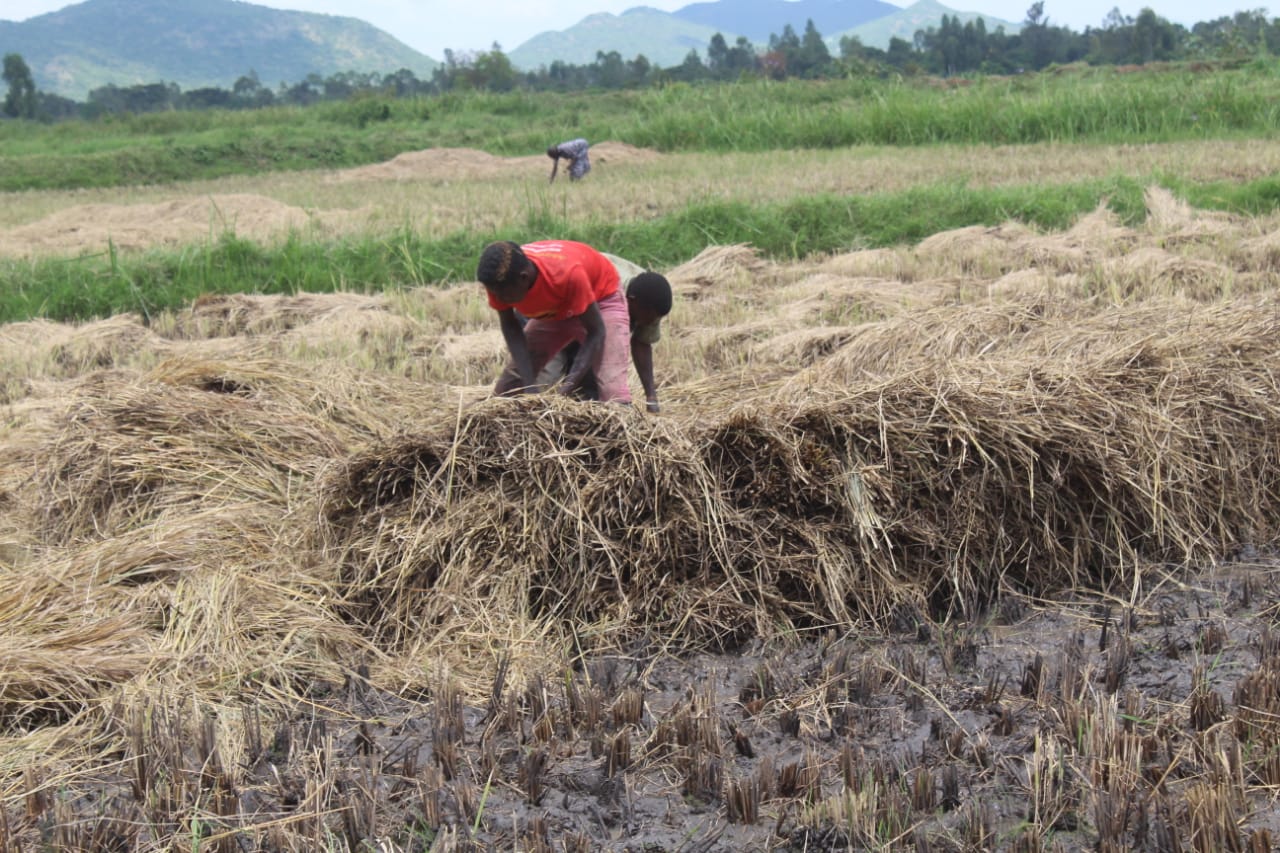 Lack of milling plants
Lack of milling plants
The only milling plant available is the Kenya National Trading Corporation KNTC that buys already milled rice but Budalangi has no milling plant.
This has forced farmers to take rice all the way to Kisumu where rice has to wait for a long time to be milled as there are also other rice farmers from the Ahero irrigation scheme who are waiting for their turn to have their rice milled.
But the National Irrigation Board is planning to build an additional storage space to help minimize the crop loss the rice farmers have been incurring. 1000 bags of rice had been dried up but unfortunately, all had been damaged by the floodwaters.
Even farm inputs had been damaged including 700 acres rice farms which were washed away by the floods and nothing was recovered.
This had forced the majority of the rice farmers to sell their livestock so as to raise the money for farming with others resorting to looking for loans from Magombe Multi-Purpose cooperative society.
The crop loss was ksh70,000 while infrastructure loss was ksh30,000 totaling to Ksh 100,000, but the National Irrigation Board rehabilitated the damaged infrastructure promptly by creating canals and rice gates.
The total rice farming land is 2500acres but plans have already been put in place by both the National Irrigation Board and Magombe Multi-Purpose Cooperative society membership to increase the acreage to 3500 acres, “A National Irrigation Board official confirms.

